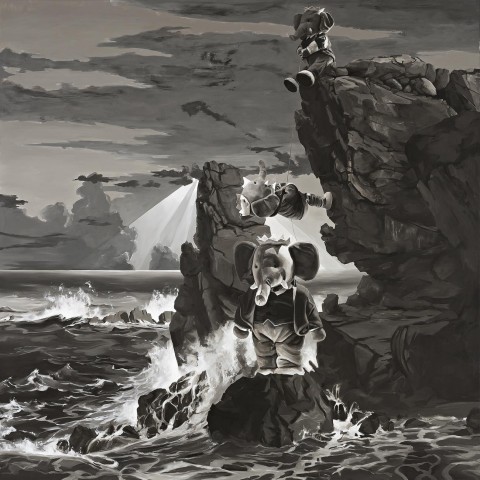LURE OF PARIS #29, 2011
STEPHEN BUSH
oil on linen
183.0 x 183.0 cm
signed, dated, and inscribed with title on stretcher bar verso: Stephen Bush The Lure of Paris #29 2011
Sutton Gallery, Melbourne
Private collection, Adelaide
Stephen Bush Online Catalogue Raisonné: [https://www.stephenjbush.com/portfolio-items/the-lure-of-paris-29/] (accessed 21/10/19)
With his exuberant eclecticism and wit, Stephen Bush is internationally renowned as the author of sublime, cryptic works that seek to confound and provoke through their incongruous juxtaposition of elements and tantalisingly playful repetition of motifs. Transforming the very act of painting into performative representations, thus his art typically contemplates the material and conceptual parameters of his metier; creativity and the role of the artist; and traditional conventions of originality and replication, with all their associated assumptions about high and low culture, authenticity and value. As Kelly Gellatly elucidates, 'At the heart of Stephen Bush's art is the constant, almost nagging question of what it means to be an artist and particularly, what it means to work in the most anachronistic of mediums – paint’.1
A recurring motif in Bush’s oeuvre, the elephant as a subject first appeared in the artist’s acclaimed ‘Lure of Paris' series (1992 – 94) featured here, with numerous monochromatic depictions of Jean de Brunoff's portly Babar the Elephant traversing a rugged, Turneresque landscape. According to the original French children's story, Babar travels from Africa to an unnamed city where he is 'civilised' by Western society – adopting Western cultural dress, customs, and behaviours – before then returning to the jungle to rule over his fellow elephants. With his natty three-piece suit and penchant for red wine and sculpture, Babar brought an unmistakably French form of civilisation to his herd – hence Bush’s title, which suggests Babar is beholden to Paris, the locus of French culture and its lure of style, order and bourgeois living. By displacing his protagonist not only from Africa and his ‘pre-civilised’ nature, but from the simple line drawings of children’s book illustration to a sublime, nineteenth-century Romantic landscape, Bush seeks to critique both colonialism and more specifically, the power of art and particular styles to create and perpetuate colonialist myths.
Exploring the language and ideologies of nineteenth-century academic painting, thus Bush’s serial treatment of the same composition in his ‘Lure of Paris’ paintings such as the present, may be understood as questioning the presumed equivalence of creativity and originality. Vowing to produce a version of the work once a year, from memory, indefinitely – and remarkably he is still going twenty-seven years later –Bush proposes, rather, a particular, circular concept of originality which, in separating creativity and originality, suggests a more complex understanding of the term that has been lost in modernist and postmodernist polemic.2 As Chris McAuliffe explains in his introduction the catalogue accompanying the inaugural exhibition of the series at Robert Lindsay Gallery, Melbourne in July 1994, ‘his paintings are doubly derivative: they emulate the conventions of the nineteenth-century landscape, and they repeat the artist’s own oeuvre’.3 Each painting is seemingly a replica of the last, yet they are all in fact individual, original pieces, handmade or ‘created’ by the artist himself without mechanical intervention or the aide of digital photography. Accordingly, as McAuliffe highlights, ‘The copy and the original here meet in paradoxical union. There is no perfect copy, it must have some originality; there is no perfect original, it must be derivative of the history of painting’.4
Indeed, with such playful theatricality, Bush's compositions – inevitably similar but always slightly different – encourage the viewer in a postmodern world deluged with simulated images ‘to push the meaning, to force a response’. As New York based art critic, Jonathan Goodman, suggests, Bush ‘… is deeply serious about the role of art as witness, which is why he keeps returning time and again to his elephant painting, to ensure 'I don't forget where that passion, all those years ago, began’.5
1. Gellatly, K., 'Stephen Bush: Steenhuffel' in Stephen Bush: Steenhuffel, exhibition catalogue, Ian Potter Museum of Art, 2014, p. 20
2. McAuliffe, C., 'Stephen Bush: Serial Originality', in Stephen Bush: The Lure of Paris, Robert Lindsay Gallery, Melbourne, 1994
3. ibid.
4. ibid.
5. Goodman quoted in Bellamy, L., ‘The long call of a little elephant’, The Age, Melbourne, 31 July 2004
VERONICA ANGELATOS
